
Paul Poiret was a French fashion designer, a master couturier during the first two decades of the 20th century. He was the founder of his namesake haute couture house.
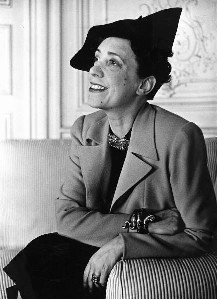
Elsa Schiaparelli was an Italian fashion designer from an aristocratic background. She created the house of Schiaparelli in Paris in 1927, which she managed from the 1930s to the 1950s. Starting with knitwear, Schiaparelli's designs celebrated Surrealism and eccentric fashions. Her collections were famous for unconventional and artistic themes like the human body, insects, or trompe-l'œil, and for the use of bright colors like her "shocking pink".

1860s fashion in European and European-influenced countries is characterized by extremely full-skirted women's fashions relying on crinolines and hoops and the emergence of "alternative fashions" under the influence of the Artistic Dress movement.

Fashion in the 1890s in European and European-influenced countries is characterized by long elegant lines, tall collars, and the rise of sportswear. It was an era of great dress reforms led by the invention of the drop-frame safety bicycle, which allowed women the opportunity to ride bicycles more comfortably, and therefore, created the need for appropriate clothing.
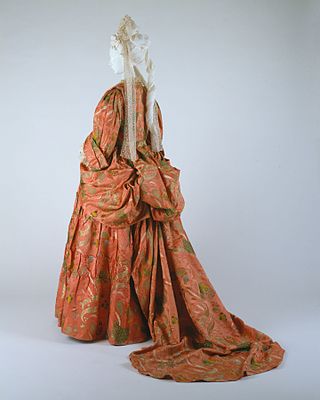
A mantua is an article of women's clothing worn in the late 17th century and 18th century. Initially a loose gown, the later mantua was an overgown or robe typically worn over stays, stomacher and either a co-ordinating or contrasting petticoat.

Jeanne-Marie Lanvin was a French haute couture fashion designer. She founded the Lanvin fashion house and the beauty and perfume company Lanvin Parfums.

Fashion in the years 1750–1775 in European countries and the colonial Americas was characterised by greater abundance, elaboration and intricacy in clothing designs, loved by the Rococo artistic trends of the period. The French and English styles of fashion were very different from one another. French style was defined by elaborate court dress, colourful and rich in decoration, worn by such iconic fashion figures as Marie Antoinette.

The robe à la polonaise or polonaise is a woman's garment of the later 1770s and 1780s or a similar revival style of the 1870s inspired by Polish national costume, consisting of a gown with a cutaway, draped and swagged overskirt, worn over an underskirt or petticoat. From the late 19th century, the term polonaise also described a fitted overdress which extended into long panels over the underskirt, but was not necessarily draped or swagged.
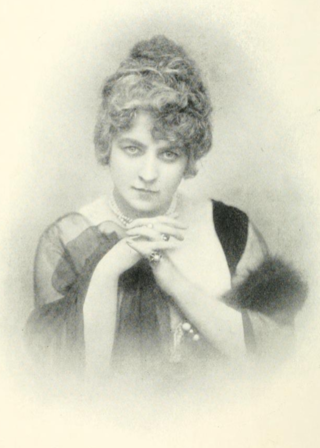
Jeanne Paquin (1869–1936) was a leading French fashion designer, known for her resolutely modern and innovative designs. She was the first major female couturier and one of the pioneers of the modern fashion business.

The most characteristic North American fashion trend from the 1930s to 1945 was attention at the shoulder, with butterfly sleeves and banjo sleeves, and exaggerated shoulder pads for both men and women by the 1940s. The period also saw the first widespread use of man-made fibers, especially rayon for dresses and viscose for linings and lingerie, and synthetic nylon stockings. The zipper became widely used. These essentially U.S. developments were echoed, in varying degrees, in Britain and Europe. Suntans became fashionable in the early 1930s, along with travel to the resorts along the Mediterranean, in the Bahamas, and on the east coast of Florida where one can acquire a tan, leading to new categories of clothes: white dinner jackets for men and beach pajamas, halter tops, and bare midriffs for women.

Fashion in the period 1900–1909 in the Western world continued the severe, long and elegant lines of the late 1890s. Tall, stiff collars characterize the period, as do women's broad hats and full "Gibson Girl" hairstyles. A new, columnar silhouette introduced by the couturiers of Paris late in the decade signaled the approaching abandonment of the corset as an indispensable garment.

Fashion from 1910 to 1919 in the Western world was characterized by a rich and exotic opulence in the first half of the decade in contrast with the somber practicality of garments worn during the Great War. Men's trousers were worn cuffed to ankle-length and creased. Skirts rose from floor length to well above the ankle, women began to bob their hair, and the stage was set for the radical new fashions associated with the Jazz Age of the 1920s.
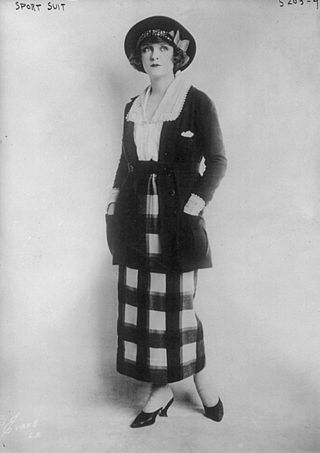
Sportswear is an American fashion term originally used to describe separates, but which since the 1930s has come to be applied to day and evening fashions of varying degrees of formality that demonstrate a specific relaxed approach to their design, while remaining appropriate for a wide range of social occasions. The term is not necessarily synonymous with activewear, clothing designed specifically for participants in sporting pursuits. Although sports clothing was available from European haute couture houses and "sporty" garments were increasingly worn as everyday or informal wear, the early American sportswear designers were associated with ready-to-wear manufacturers. While most fashions in America in the early 20th century were directly copied from, or influenced heavily by Paris, American sportswear became a home-grown exception to this rule, and could be described as the American Look. Sportswear was designed to be easy to look after, with accessible fastenings that enabled a modern emancipated woman to dress herself without a maid's assistance.
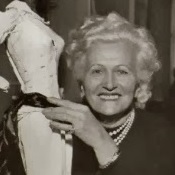
Marie-Louise Bruyère, mostly known as Madame Bruyère, or simply as Bruyère, was a French fashion designer of the 1930s, 1940s and 1950s, operating out of Paris, and importing her fashion lines abroad.
Marcelle Chaumont was a French fashion designer.

A draped turban or turban hat is a millinery design in which fabric is draped to create headwear closely moulded to the head. Sometimes it may be stiffened or padded, although simpler versions may just comprise wound fabric that is knotted or stitched. It may include a peak, feather or other details to add height. It generally covers most or all of the hair.
Philippe et Gaston was a Paris couture house established in 1922. It rapidly became a prestigious establishment. In 1926 it was ranked alongside Chanel, Madeleine Vionnet and Jeanne Lanvin as a notable French fashion house. By 1931, it was well known enough to rate a mention in Bruno Jasieński's 1931 play The Ball of the Mannequins. However, by 1946, the house was in need of resurrection. That year, the French textile baron, entrepreneur, and one of France's richest men, Marcel Boussac invited Christian Dior to become head designer for Philippe et Gaston and rejuvenate the brand. Dior declined, as he wanted to launch his own label under his own terms, rather than resurrect an "old-fashioned and rundown house." Boussac and Dior subsequently launched Christian Dior S. A.
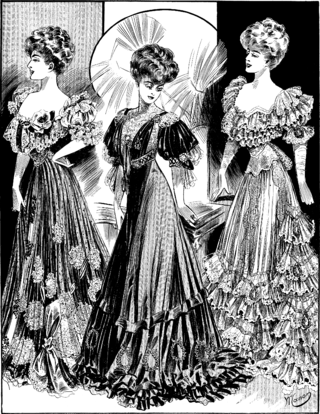
Boué Soeurs was a French fashion house active from 1899 to 1957. It was founded by sisters Madame Sylvie Montegut and Baronne Jeanne d'Etreillis under their maiden name, Boué.

Jeanne Victorine Margaine-Lacroix was a French couturier of the early 20th-century. The House Margaine-Lacroix is mainly known today for having revolutionized the world of fashion by creating the so-called Sylphide or Tanagréenne dress, cut to be worn without a corset.

















